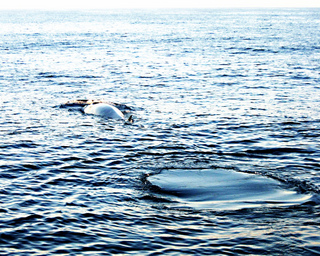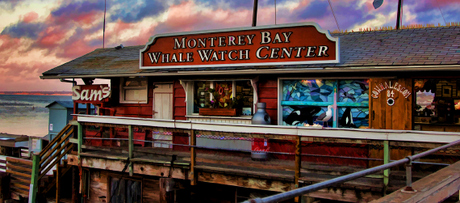Discover Northern California's
Whale Watching Tips
Whale Watching Tips for a Successful Venture
Having spent many years whale watching in almost every way imaginable, we have some tips we'd like to share with you. California whaling can be as simple as driving or hiking along the coast, or just picking a spot to sit anywhere along Northern California's coastal roads, rocky bluffs, and sandy beaches.
Whaling cruises are a popular choice as you can go to the whales rather than waiting for them to come to you.
If you're really brave, paddle a canoe or kayak out into the ocean - many people have done it and been real up close and personal. Not sure we can recommend it, though!
You might even be able to do some whale spotting from the air by plane, helicopter, or even in a blimp.
But before heading out, continue reading to learn how to plan your trip, where to go to increase your odds of success, what to look for when you get there, and what to bring along, whether you opt for whaling trips ashore, asea, or aloft.
Do you have a favorite
NorCal story?
From a family visit from years ago to something
you discovered last weekend,
Share it with
the rest of us - we'd love to learn about it!
And for your hotel needs during your trips, you can't go wrong with saving money at HotelsCombined.com:

Northern California Whale Watching Tips
|
|
Northern California whaling is some of the best - with at
least eight species of whale, you can whale watch all year round! Northern California whaling is some of the best -with at
least eight species of whale, you can whale watch all year round!
|
- Pick a spot that's known for its spotting whales: Of course, you might happen to spot a whale or two from almost anywhere along the California coastline if you're in the right place at the right time, but there are areas that are renowned for whale sightings - that's where you want to be!
- Plan your trip for peak whale watching season:
December to May - Gray whales are migrating, with the peak month being February
June to September - Best time to see whales that Summer off Northern California, like Orcas
August to October - Best time to see Humpbacks and Blue whales. - Choose a calm, clear day if possible:
Whales are much easier to spot if the sea isn't choppy. - Be prepared to be patient as well:
Although whales are giant creatures, they're not always easy to spot; be patient! - Things to bring along:
A good pair of binoculars;
A camera or video cam with a decent zoom lens;
Sun screen and sun glasses;
Warm clothes, in case it turns nippy;
A picnic lunch, snacks, and something to drink
How to whale watch, and what to look for: when you're on a whale spotting trip, this is how to go about it and what you'll be looking for...
- Scan the surface of the water rather than looking down into it
- Look for a blow, or spout - when the whale surfaces after a dive, he'll blow the air out through his blow hole, creating a misty vapor jet
- Also look for
whale footprints, especially if you're on a high promontory or in a boat or
plane - you may be able to spot the glassy mark a whale makes on the
surface of the ocean, almost like an oil slick (see the photograph above)
- Plan your trip for peak whale watching season:
December to May - Gray whales are migrating, with the peak month being February
June to September - Best time to see whales that Summer off Northern California, like Orcas
August to October - Best time to see Humpbacks and Blue whales.
- Choose a calm, clear day if possible:
Whales are much easier to spot if the sea isn't choppy. - Be prepared to be patient as well:
Although whales are giant creatures, they're not always easy to spot; be patient! - Things to bring along:
A good pair of binoculars;
A camera or video cam with a decent zoom lens;
Sun screen and sun glasses;
Warm clothes, in case it turns nippy;
A picnic lunch, snacks, and something to drink
How to whale watch, and what to look for: when you're on a whale spotting trip, this is how to go about it and what you'll be looking for...
- Scan the surface of the water rather than looking down into it
- Look for a blow, or spout - when the whale surfaces after a dive, he'll blow the air out through his blow hole, creating a misty vapor jet
- Also look for
whale footprints, especially if you're on a high promontory or in a boat or
plane - you may be able to spot the glassy mark a whale makes on the
surface of the ocean, almost like an oil slick (see the photograph above)
For more whaling tips and information, click on any of the links below:
- Tips for When You're Ashore
Tips to help you spot whales from ashore - Planning Your Whaling Trip Ashore
What you need to know for spotting whales from Northern California shores - Tips for When You're Asea
Tips to get the most of your whaling from a boat - Planning Your Whaling Trip Asea
What you need to know for arranging your trip from a boat - Tips for When You're Aloft
Tips to help you get the most from spotting whales from a plane - Planning Your Whaling Trip Aloft
How to plan a whaling trip from the air - Whale Videos
See what you've been missing!
Please continue your exploration of what Northern California has to offer by using the Nav Bars in the left and right columns or by using the links at the bottom of the page.
Like what you're finding here at Discovering Northern California? Then please share with the Social Network of your choice.
And thanks for coming!
Related Articles
Whale Watching
Whale Watching Tips
Planning Your Trip Ashore
WW Tips Ashore
Planning Your Trip Asea
WW Tips Asea
Planning Your Trip Aloft
WW Tips Aloft
Related Pages
Things To Do
Activity Village
Attractions
Beaches
Beer Lovers Delight
Burney Falls
Camping
Casa de Fruta
Day Trips
Gold Panning
Gold Rush Sites
Healdsburg
Historic Grass Valley
Lake Shasta Caverns
Lodi
Missions
Nevada City
RV Destinations
Ski Resorts
Tide Pool Tips
Travel Tips
Weekend Trips
Whale Watching
Wine Tasting
Related Pages
Hints & Tips
Beach Safety Tips
Best Kept Travel Secrets
Family Camping Tips
iPhone Travel Apps
Nude Beaches
Tide Pool Tips
Travel Sites We Love
Travel Tips
Whale Watching Tips
Wine Tasting Tips
Winter Driving Tips
Related Pages
Insider Secrets
Best Kept Travel Secrets
Best Winter Whitewater
Boring Road? Nope
CA Admission Day
Climbing at Castle Rock
Crabbing Spots
Dream of Dreams
Fall in Eastern Sierras
Ghost Stories
Glass Beach
Great Stays, Low Pays
How to be a Valley Girl
Jade Beach
Lake Shasta Caverns
Lassen Volcanic SP
Lost Coast
Mono Lake
Moss Landing: Whales
New Clairvaux Abbey
Panning for Gold
Pygmy Forest
Mendo to Eureka
RV Destinations
SF Great Places to Eat
SF: More About Eating
SF Neighborhoods
SF Giants Baseball
Santa Cruz: Memories
Santa Cruz: Old Friends
Sonoma Cooking Class
Sonoma History
Sonoma Top Wine Stop
Tahoe: Discovery Trail
Underground Gardens
Yosemite: Family Hikes
Yosemite: High Country
YNP: Off the Beaten Path
Yosemite: Taft Point
Ziplines

